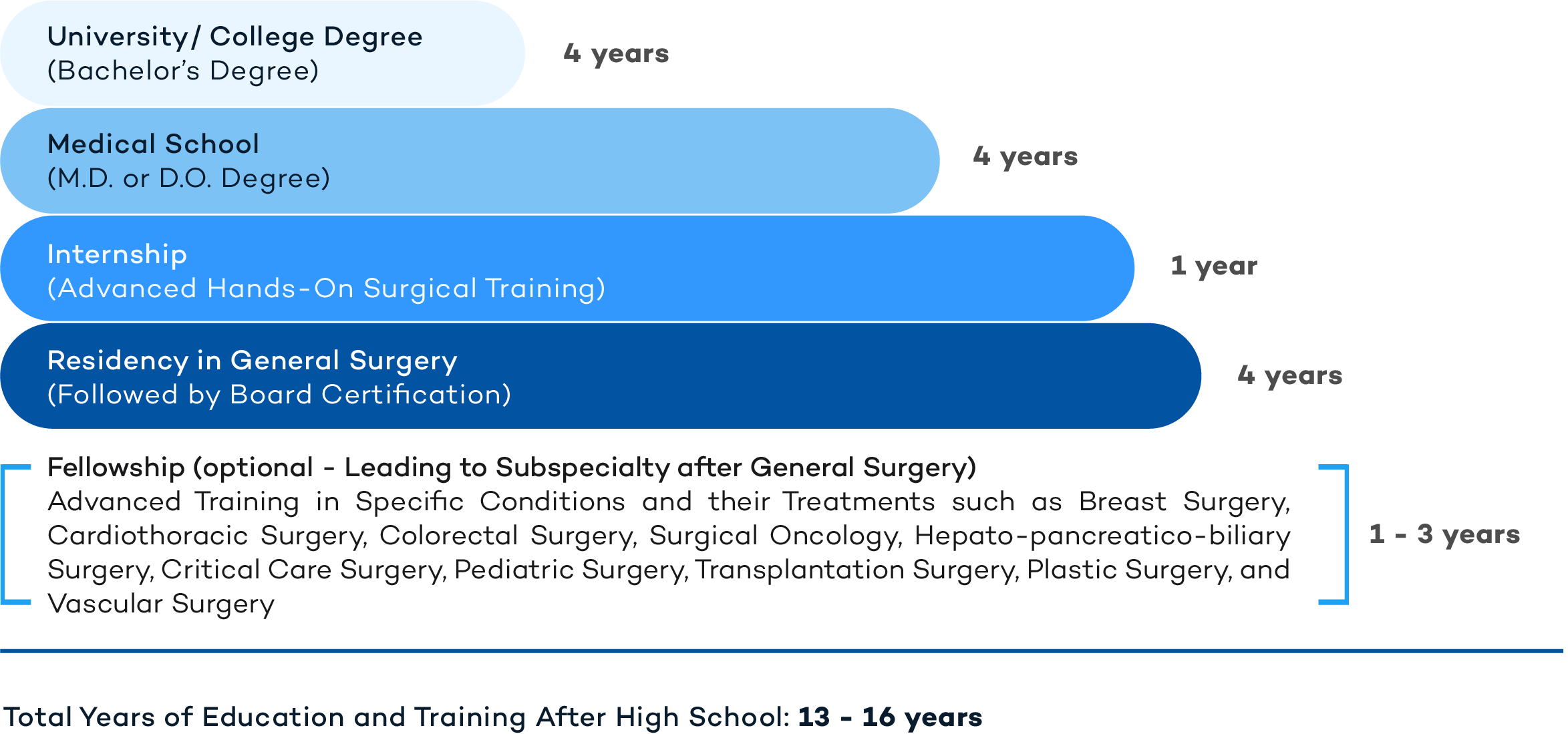

A General Surgeon is a Board-Certified Doctor who has experience in the surgical management of diseases of the gastrointestinal tract, breast, skin and soft tissues, the vascular system (excluding the brain and heart), the endocrine system (thyroid, parathyroid, pancreas, and adrenal glands), and the entirety of the abdomen and pelvis and its contents. These Physicians also manage the surgical needs of acute trauma, surgical oncology, and the critically ill who require surgical intervention..
Most commonly, patients are referred to the General Surgeon for care after seeing their Primary Care Doctor (Internal Medicine, Family Medicine, Pediatrics, or OB/GYN), who is typically the first Specialist in their care to diagnose a condition which requires a surgical intervention.
The level of expertise to surgically treat specific conditions and the credentials necessary are important factors when choosing the right physician. You may do your diligence and check the credentials and practice style of your doctor with the help of your family and friends. At myDoqter, we facilitate this process by providing you with access to patient feedback about doctors, as well as to the professional recommendations given by other physicians who have witnessed first-hand the expertise and professional competency of your General Surgeon.
General Surgeons are doctors (M.D. or D.O.) with advanced medical degrees and training. The following is a representation of the years of education and training that these physicians have undergone.

A General Surgeon serves a critical role in the management of disease states that require surgical intervention. Some of the more common procedures they perform include:
Appendectomy: This term refers to the surgical removal of the appendix, a small pouch attached to the large intestine in the right lower quadrant of the abdomen. Inflammation of the appendix, also known as appendicitis, is a very common surgical emergency. Appendicitis is an infection of the appendix with swelling (edema), infection, and intense pain. Diagnosis of appendicitis is based on a physical exam showing pain upon palpation in the mid abdomen (that often radiates down to the right lower quadrant), an elevated white blood cell count (indicating possible infection), as well as evidence of inflammation on X-Ray, CT scan or MRI. Radiographic imaging studies may be used for confirmation of an appendicitis in some cases, since the location of the pain may be confused with kidney stones, ovarian or testicular cysts, or torsion (twisting) of the ovaries. The appendix may be removed through an open incision into the abdomen or, less invasively, through a laparoscopic procedure. A laparoscopic appendectomy may have less scarring and an overall shorter recovery time, with a reduced hospital stay. If the appendix is left untreated, it may burst (as early as 48-72 hours after the start of the pain) and may lead to peritonitis (a widespread infection of the abdomen and its contents) which may become fatal.
Breast Surgery: General Surgeons perform the majority of non-cosmetic breast surgeries, mostly related to the treatment of breast cancer. These physicians perform breast biopsies where just a small portion of tissue is removed. They also perform lumpectomies to remove a discrete tumor from the breast, as well as mastectomies where one or both breasts are removed either due to widespread disease or prophylactically in those with significant personal or family history of breast cancer.
Colon and Rectal Surgery: While some General Surgeons operate on the colon and bowel, many of these physicians have received further fellowship training in Colorectal Surgery. These surgeries are usually performed for colon cancer, bowel obstructions, diverticulitis, Crohn’s disease, and hemorrhoids. A colectomy is a bowel resection and involves removing all or part of the large intestine. A colostomy is a surgical procedure whereby the colon is attached to an external opening in the abdomen (stoma), and may be permanent or temporary depending on the nature of the underlying condition.
Esophageal Surgery: The esophagus is the organ that connects the oral cavity to the stomach. Several esophageal conditions may be managed with surgical interventions. These include esophagectomy (partial removal of the esophagus) for esophageal cancer and Barrett’s Esophagus (a pre-cancerous condition of the lower esophagus resulting from damage from longstanding acid reflux disease). A fundoplication procedure may also be performed to help address gastroesophageal reflux disease (GERD). In this procedure, the surgeon will attach part of the patient’s stomach to the lower esophageal sphincter to reduce acid reflux and subsequent tissue damage.
Gastroenterology Procedures: Some of the more common surgical procedures involving the gastrointestinal tract include performing liver biopsies to detect cancer or other diseases of the liver, as well as bariatric surgery for the morbidly obese. Gastric bypass is the most common type of weight-loss surgery, where changes are made to the stomach and small intestine that directly affect the absorption and digestion of food. Gastric bypass surgery is prescribed for individuals with a body mass index (BMI) over 40, with uncontrolled hypertension or type 2 diabetes, or sleep apnea associated with their excessive weight. Weight-loss surgery may reduce long-term mortality by up to 40%, and allow patients to lead more normal lives on fewer mediations and with improved quality of life.
Gallbladder Removal: A cholecystectomy, or gallbladder removal, is most commonly performed to alleviate symptoms related to gallstones (hardened deposits within the gallbladder). Those most at risk of gallstone development include overweight individuals, those with a high fat or cholesterol diet, pregnant women, or those with a strong family history of the disease. Gallstone development may be acute or chronic, and the presenting symptoms include right upper abdominal quadrant pain, nausea, vomiting, clay-colored stools, dark urine, diarrhea and/or indigestion. Acute inflammation of the gallbladder (acute cholecystitis) occurs when a gallstone blocks the duct that removes bile from the gallbladder. This acute condition is a surgical emergency and may be associated with intense abdominal pain with fever and chills. If left untreated, gallstones can lead to not only inflammation and infection, but also bile duct infection (cholangitis), sepsis (infection spread throughout the blood and to various organs), pancreatitis (inflammation of the pancreas), and gallbladder cancer. Treatment for most gallbladder conditions involve its complete surgical removal either through an open incision or via a laparoscopic procedure.
Hernia Repair: Abdominal hernias occur when there is a weakness or opening in the muscle of the abdominal wall, and the lining of the wall protrudes through and forms a palpable bulge. Activities such as straining or coughing, which increase intra-abdominal pressure, tend to exacerbate hernias and make them more painful. If any portion of the intestines become trapped in the hernia, then this can lead to a life threatening condition called ‘incarceration’ where the blood supply is interrupted and there is tissue death. Inguinal (groin) hernias are the most common type of hernias due to the natural muscle weakness in this area. Epigastric (upper central abdomen), umbilical (at the belly button), hiatal (stomach pushes up through the diaphragm muscle internally), incisional (at the site of a previous surgery), and internal hernias (within the abdomen) are all possible wherever there is a weakness in either the muscle tissue or the overlying structures of the skin. Hernia repair, also known as herniorrhaphy, may be performed through an open surgical approach or via a laparoscope.
Thyroid Removal: The thyroid gland is a small gland at the front of the neck, and it is responsible for producing hormones that influence metabolism, growth and development, and the regulation of body temperature. The most common reason for thyroid surgery is the development of thyroid nodules or tumors. Although these nodules may be benign, their growth may stimulate excess thyroid hormone production and lead to hyperthyoidism. The symptoms of this condition include weight loss, irritability, sweating, and irregular heartbeats. Surgical removal of benign or malignant nodules can be curative in some cases of hyperthyroidism. Removal of a goiter, an enlargement of the thyroid gland, is also possible through surgery.
Spleen Removal: The spleen is located in the left upper quadrant of the abdomen and primarily acts as a filter for the blood. The spleen is responsible for removing old and damaged red blood cells from the circulation. The spleen also stores blood and helps us to fight off infections. The spleen is not necessary for survival and may be removed surgically (splenectomy) if it is enlarged or damaged from injury, has large cysts or cancerous cells, or in certain blood disorders (sickle cell anemia, polycythemia vera, or hemolytic anemia). Anyone who has had their spleen removed is at increased risk of infection for life. These patients will require yearly vaccines and prophylactic antibiotics before all dental and surgical procedures due to their compromised immune function.
General Surgeons provide comprehensive surgical guidance and treatment for patients with a wide variety of medical conditions. They are well versed in the anatomy and physiology of the human body and receive highly specific training to properly address illnesses and injuries that can be treated or cured through surgical interventions.
You can read more about General Surgery in the following links:
https://www.absurgery.org/default.jsp?aboutsurgerydefined
https://www.facs.org
https://www.journalacs.org
https://theasgs.org/join-us-membership/